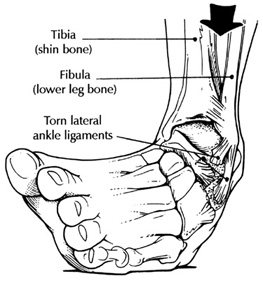Archive
Ankle Sprains
 An ankle sprain occurs by stretching or tearing one or more ligaments on either or both sides of the ankle. Ignoring a sprain won’t help it heal any faster. Ankle injuries that are serious enough to cause disabling pain should be treated by a podiatrist. Further examination may even reveal a torn ligament or bone fracture. Common treatments for sprains include rest, elevation, compression, and ice. More serious sprains may call for crutches or other walking devices.
An ankle sprain occurs by stretching or tearing one or more ligaments on either or both sides of the ankle. Ignoring a sprain won’t help it heal any faster. Ankle injuries that are serious enough to cause disabling pain should be treated by a podiatrist. Further examination may even reveal a torn ligament or bone fracture. Common treatments for sprains include rest, elevation, compression, and ice. More serious sprains may call for crutches or other walking devices.
If you have questions about ankle sprains, we have much more information on our website www.nastfootandankle.com. For an appointment please call our office at 305.220.3636 or visit our website for an appointment request. You can also sign up for our newsletter and request my FREE podiatry book.
Jorge F. Nasr, DPM
11760 Bird Road, Suite 610
Miami, FL 33173
305.220.3636
www.nasrfootandankle.com
Complex Regional Pain Syndrome
The cause of patient pain is not always apparent. After an ankle sprain, for example, a patient may come into the office with pain out of proportion for the injury that he or she incurred. When all other causes of pain have been ruled out, a physician may suspect complex regional pain syndrome, or reflex sympathetic dystrophy. While the most common cause of CRPS is an ankle sprain, crush injuries, surgical incisions, or other trauma can be the cause of CRPS. CRPS is classified into two types: Type I (RSD) involves pain, temperature changes, limb edema, skin discoloration, and abnormal sweating. Type II (causalgia) is similar to type I, but it involves a peripheral nerve lesion that can be isolated. The most common nerve damaged in Type II CRPS is the superficial peroneal nerve.
Making the diagnosis of CRPS early is essential so that treatment can begin promptly. One of the best ways to detect CRPS, aside from patient history and clinical signs, is to order a triple phase bone scan. In a patient with CRPS, there will be increased blood uptake in an area of the limb in question that is apart from the location of the original injury. When a physician sees this finding, CRPS should be one of the first diagnoses on his list. Treatment for CRPS should begin as soon as possible to ensure that the patient gets maximal relief. The limb must not be immobilized and the patient should begin physical therapy immediately. Other therapies for CRPS may also include nerve blocks, oral steroids, and even oral anti-depressants.
If you have questions about Complex Regional Pain Syndrome, we have much more information on our website www.nastfootandankle.com. For an appointment please call our office at 305.220.3636 or visit our website for an appointment request. You can also sign up for our newsletter and request my FREE podiatry book.
Jorge F. Nasr, DPM
11760 Bird Road, Suite 610
Miami, FL 33173
305.220.3636
www.nasrfootandankle.com